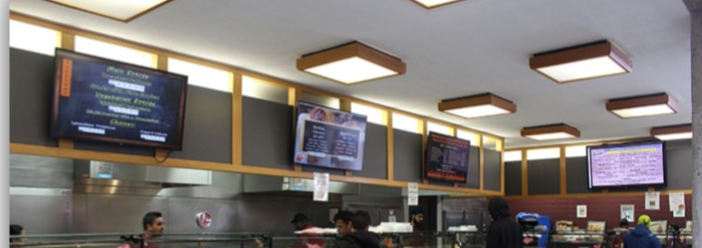Restaurant Digital Signage Best Practices
It’s becoming more and more common to see digital signage in restaurants, simply because restaurants are the ideal market for digital menu boards and digital signage. Restaurants are constantly in a position to upsell products (specifically those with an ordering line), make consistent changes to menus and have a captive audience. However, successful digital menu display in a restaurant environment is more than a digital menu board for restaurants- it’s about taking advantage of the opportunities digital signage gives your business without overdoing it. If you have made the wise decision to go with digital signage software versus a TV menu, then you’re in luck! Instead of implementing your digital menu boards in the same way you did your printed menus, play off some of the digital signage software features to get the most out of your investment:
-
Upsell, upsell, upsell!
According to Digital Signage Today, 70% of people exposed to digital signage make an unplanned purchase. That number is too big to not act on. A very obvious advantage of digital over printed signage is the ability to catch the eye of your audience. This gives you the perfect opportunity to upsell some dishes that may not be getting the attention they deserve. Take advantage of dynamic imagery and animations to bring even more attention to your featured dish.
-
Create Brand Loyalty
So you have all of the makings of a favorite neighborhood restaurant- friendly staff to greet guests at the counter, affordable pricing, great location and an incomparable food. You want people to come back on a regular basis and in order to do so- they can’t get bored. Menu changes are simple and quick with digital menu boards templates, but why not take it a step further? Customize your electronic menus for seasons or personalize them for valued customers. Digital Menu Boards are so easy to update that you can do a weekly change to your menu design. This way customers have something new to look at while still ordering up their classic favorites!
-
Use Videos
In my opinion, there is nothing more engaging and persuasive in the restaurant industry like an impressive video of food being enjoyed. If you have paid good money for video editing- why not use it in more places than a television commercial!? Videos are one of the most underrated and underused benefits of digital signage and a great video is sure to make a sale. For example, I was in a certain fast food chain known mainly for quick burgers on the run. As I was waiting in line for my food, I noticed down the center of their digital menu board was a video of coffee slowly pouring on to a bed of ice. Can you guess what I got back into line to order? I just hadn’t considered this establishment as a place to get my ice coffee, but I was sold based solely on their digital signage.
-
Day-Parting is Your New Best Friend
Day-Parting is the feature that allows your digital menu boards to begin playing new content at a scheduled time, without someone needing to manually change it. Those in charge of making menu updates simply log in to their server and schedule new content to appear on a one-time basis or even switch over every day. For example: One of our digital menu board owners is a college campus dining hall. Every day, their stations switch over from breakfast, to lunch, to dinner. They have their menu choices pre-programmed at the beginning of each week so when the time for change comes, they don’t need to think twice about it.
-
Steer Clear of “Take-Over” Mode
While it is considered a benefit of digital signage, I don’t find it useful in the restaurant industry. In fact, I find that “take-over” mode gives digital signage a bad name. When I say “take-over” mode I mean the feature that allows all menu items to disappear and one image or message to be flashed across the multi-screen menu system for a short period of time before switching back to the menu. This quite obvious why this might be irritating for customers trying to place an order, specifically those that are wary of technology in the first place.
The key in digital menu boards is to use the features to their full extent, but don’t overuse them. Come up with a detailed and comprehensive marketing plan for your digital menu boards the same way you would a marketing plan.





